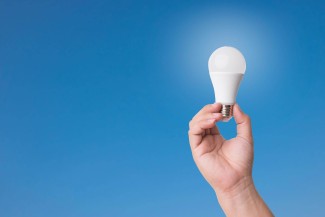Washington, DC—To reduce climate-warming emissions and save consumers money, the Biden administration took a major step today to finally ensure that light bulbs don't waste energy. In a rule, the Department of Energy (DOE) proposed that some of the most common types of bulbs be required to meet federal standards for energy efficiency.
The bulbs at issue are used in two billion sockets in the United States. They include reflector bulbs used in recessed and track lighting, candle-shaped bulbs used in wall sconces and other decorative light fixtures, and globe-shaped bulbs often installed in bathrooms.
The DOE reiterated today that it is considering an additional step to ensure these light bulbs as well as pear-shaped bulbs—used in another 3.4 billion sockets—do not waste most of the energy they use by converting it to heat. In May, the department solicited initial public comment on that step, which would require that bulbs produce at least 45 lumens per watt (a measure of how much visible light is produced for a given amount of electricity) by reinstating a "backstop" standard Congress set in 2007 that is easy for today's LED light bulbs to meet.
“This saga is winding to an end and the question now is whether the manufacturers are going to be able to squeeze out a few more years of profits from these wasteful products,” said Steven Nadel, executive director of the American Council for an Energy-Efficient Economy (ACEEE). “The Biden administration needs to get this done promptly because every extra month energy-wasting bulbs are sold locks in $300 million in needless energy costs for consumers.”
The cost to the climate of a full extra year of delay in phasing out incandescent light bulbs would be 9.5 million metric tons of carbon dioxide emissions, according to an analysis by the Appliance Standards Awareness Project (ASAP) submitted to DOE. That’s equivalent to the emissions from two million cars operating for a year.
“We’re talking about 19th century technology that burns out every year, which has worked out much better for the sellers than for the buyers,” said Andrew deLaski, executive director of ASAP. “The LED options are so affordable and last so long that it’s just predatory at this point to sell incandescent bulbs that cost a lot to use and need to be replaced frequently.”
The Obama administration’s DOE—directed by law to consider updating which bulb types should be exempted from federal efficiency standards—determined in January 2017 that several types of common bulbs should not be exempted. It also said that the legal backstop had been triggered, setting the stage for the 45-lumen-per-watt standard to take effect at the beginning of 2020.
After President Trump entered office, the National Electrical Manufacturers Association (NEMA)—a trade group representing major light bulb manufacturers (Philips [now known as Signify], General Electric, and Sylvania/LEDVANCE)—sued DOE over the Obama rules. The Trump administration settled with NEMA that year, committing to revisit the issue. DOE issued two final rules in 2019, one reinstating the exemptions and the other asserting that the backstop standard had not been triggered.
Since then, California and Nevada have implemented 45-lumen-per-watt standards. Consumers in those states are already guaranteed efficient bulbs, generally LEDs. A typical incandescent bulb emits approximately 15 lumens per watt; in comparison, its LED equivalent emits more than 100 lumens per watt.
Nationally, while sales of LED bulbs have grown rapidly, the newest data available show that about 30% of light bulbs sold in 2020 (in states excluding California) were still incandescent or halogen incandescent bulbs.
In June, NEMA submitted comments to DOE asking the agency for another year of continued manufacturing and importing of inefficient bulbs followed by a year more to sell out stockpiled inventory. Signify, the world's largest lighting company, seconded the request for more time to make or import wasteful bulbs, followed by the ability to sell the bulbs for a to-be-determined period. The People’s Republic of China called for a “transition period of at least three years.” By law, the backstop should have become effective in January 2020.
DOE has until the end of the year to potentially finalize today’s proposal as well as a possible action reinstating the backstop standards, based on provisions of an executive order from President Biden and a subsequent memo from DOE.
The American Council for an Energy-Efficient Economy (ACEEE), a nonprofit research organization, develops policies to reduce energy waste and combat climate change. Its independent analysis advances investments, programs, and behaviors that use energy more effectively and help build an equitable clean energy future.
The Appliance Standards Awareness Project (ASAP) organizes and leads a broad-based coalition effort that works to advance, win and defend new appliance, equipment and lighting standards which deliver large energy and water savings, monetary savings and environmental benefits.

